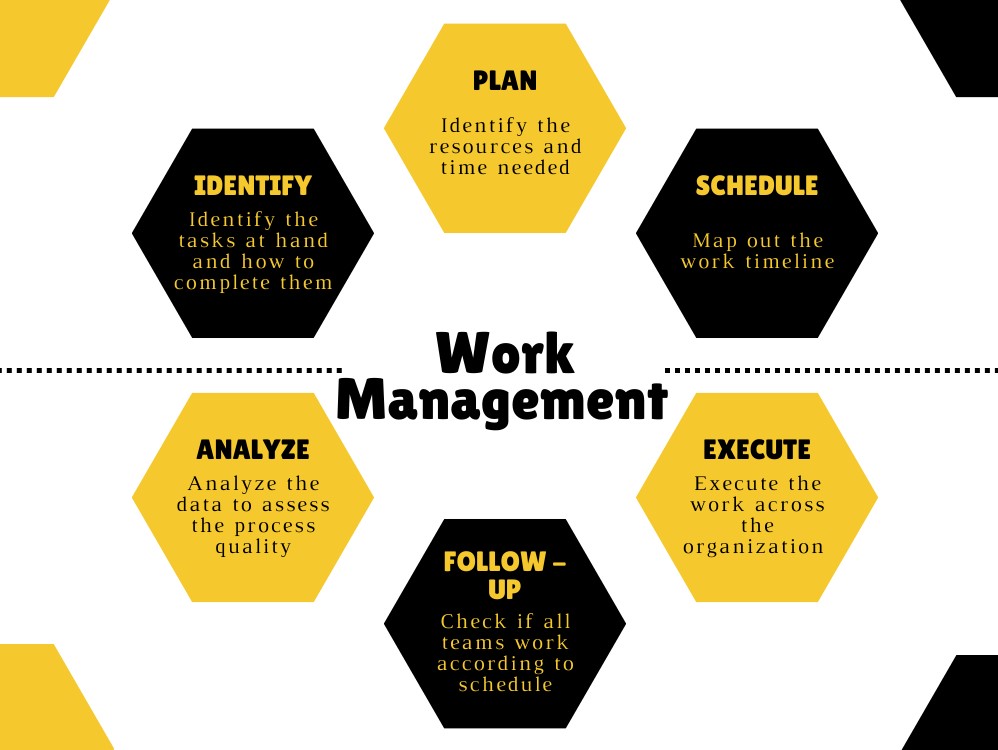Work management is a systematic way of helping businesses create and oversee an efficient workflow structure across all levels of the organization. It aims to optimize the orchestration of workflows and processes, ensuring all teams and individuals work efficiently without delays, errors, or disruptions.
That said, the primary goal of work management is to improve the organization’s overall business performance through the delivery of consistent and quality work. Effective work management contributes to:
- enhancing the company’s productivity and likelihood of goal achievement (across all levels);
- eliminating disruptions and redundancies across work activity;
- improving resource and time management;
- boosting collaboration across the company;
- reducing risk and ensuring adherence to security and regulatory requirements;
- improving an organization’s client and employee experiences.
In general, work management is a comprehensive and challenging subject but it is a fundamental and crucial aspect of executing well in any enterprise business environment. And to have effective work management, a systemized approach will be required. But where do you start?

It’s important to first understand that work management requires a deeper look at the workflows and processes that make up the overall approach to executing work in a company. Secondly, there are steps you’ll want to follow to build a work management discipline, methodology, or approach that suits your environment. Taking a step back to assess and plan will help you deliver stronger outcomes. Six Steps to Building a Work Management Approach.
Creating a work management framework or discipline for your business can be broken down into six key steps – work identification, evaluation, planning, scheduling, execution, and follow-up (which includes analysis).

1. Identification
The first step in building a work management framework is identifying and reviewing the current workflows and processes within the organization. While this may seem a bit daunting, all work can typically be looked at through a workflow and process lens. Keep in mind that starting small may be the best course of action if you’ve not spent a lot of time at this point trying to understand your organization’s workflows.
Consider starting at the team or department level rather than trying to tackle an entire company when just getting started. It’s well understood that enterprise companies are complex. Keep the broader organization in mind but if starting small helps facilitate taking action, go that route. The purpose of the identification step is to gain a solid understanding of what is being executed and managed and to identify all of the components, assets, resources, and related activities that occur with any given process or workflow.
2. Evaluation
Once the identification step is complete, you will want to assess how the workflows and processes are performing. On some level, you will have a gut feeling about where there may be issues, but try to be a bit more “scientific” with your evaluation. Here are a few questions to consider.
Do any of the workflows or processes:
- have bottlenecks, time delays, or coordination issues?
- cause you to miss key performance indicators (KPIs) or other objectives in your organization?
- cost more time, budget, or resources than they should?
- lack transparency and visibility needed to be managed effectively?
- put the organization at risk for financial, reputational, or other loss?
Ultimately, the evaluation phase will help you decide which workflows and processes require immediate attention and improvements. Once you identify what works and what doesn’t, you can move on to the next step to decide how you intend to improve your organization’s operations. You might find that none of your workflows or processes need to be fixed but they offer an opportunity to accelerate better business performance when modified.
3. Planning
The third step is developing an action plan. Reflect on your current workflows and see how you can improve them. Based on that, start building a plan of how you will implement the improvements and better systemize work across your team, department, or organization. Consider people, process, and technology in your plan and think about how corporate culture may affect your ability to be successful when trying to make changes. Estimate the time it will take to design, build and deploy the new approach while considering other stakeholders that need to be involved in the decision-making process. When planning your work management processes, a good rule of thumb is to break down the tasks that make up each workflow or process. Then identify all relevant assets, artifacts, resources, etc. that are required as part of the work. Do this for even the simplest of workflows and processes. It might seem like overkill, but often it’s the tasks that seem the least significant in an organization that may have the most substantial impact on how processes and workflows perform.
The planning step will also help you decide where automation can be leveraged to enhance workflow performance even further. Workflow automation can certainly help all aspects of work management at scale. The key is to find the solution that allows everyday business users, managers, and leaders the opportunity to build and deploy on their own. IT will always be a key stakeholder but having a tool that anyone can implement will enhance an organization’s ability to get things done – quickly and easily. Keep in mind that those closest to the work are the ones most capable of deciding where automation comes into play.
4. Communication
Once you have your plan, the next step in building a work management framework is communicating the plan and securing buy-in from those who will be involved in following the new plan.In this step, managers and/or team leads share insights, objectives, and action items that map out work across days, weeks, or months. Timelines and plans need to be completely visible and understood before taking action. Communicating workflow timelines and responsibilities is certainly vital for elevating the company’s performance, but it’s equally important to have team members understand and embrace the new work management philosophy as well. Create a two-way communication channel and a culture where feedback is encouraged and embraced. Armed with more knowledge and insights, team members will have a better opportunity to perform at their best, and a more engaged team leads to the development of innovative ideas, improved productivity, work performance, and job satisfaction.
5. Execution
Once the work management plan and timeline are established and everything has been communicated effectively, it’s time to act. During this stage, the teams start working on tasks, processes, and workflows following the new and improved approach.
The manager’s job here is to monitor the team’s progress, ensuring there aren’t any disruptions, bottlenecks, or miscues in the workflow and processes that make up the new work management framework. The vital part of the execution step is documenting everything to capture newly designed workflows, processes, and communications. As part of the work management framework, technology will likely be considered. If not, go back to the planning step to consider all the tools that may be needed. There is any number of platforms that can help accelerate and effectively manage some or all of the effort. Seriously consider whether continuing to manage things in emails and spreadsheets will get you where you need to be.
6. Follow-Up & Analysis
With the new approach up and running, managers need to gather data and insights on how everything is working. Escalations, bottlenecks, errors, and missed deadlines are some critical “red flags” to be noted. Real-time reporting comes in handy here as well if a workflow automation platform is put in place as part of your new work management framework. This allows managers to make decisions on the fly and to quickly adjust to mission-critical changes that are required.
The last step in deploying a new work management approach is to see how everything is performing. Work management can span a single or multiple workflow (s) or process (es); some being far more complex than others. During the planning phase, it is very important to have identified all the data points, metrics and information that needs to be gathered to assess performance. Reporting and documentation of outcomes will provide insights needed to make any adjustments to the work management activity. As previously mentioned, new work management frameworks may still have leeway for using spreadsheets and emails. However, it is recommended to look at workflow and process automation platforms that enable real-time data gathering and reporting.
The questions to ask during the analysis step are:
- were all tasks and workflows completed on time?
- what was the quality of work within different teams?
- was the orchestration between the teams satisfactory?
- were there any disruptions and roadblocks?
- what could’ve been done differently to improve outcomes?

How to Streamline Work Management Practices?
The steps involved in developing and deploying effective work management practices only proves the comprehensive nature of the concept. It takes a lot of planning and effort to improve how “work ” flows” but when done correctly, using a framework or well-defined approach to how activities and tasks get done can help take any company’s performance to a whole new level.
The good news is that managers don’t have to do everything themselves. Thanks to innovative and comprehensive technology solutions specifically designed for managing work at scale, companies can take advantage of workflow and process automation tools and platforms, such as HighGear.
Using HighGear’s state-of-the-art workflow management platform, managers can streamline work management processes across all teams and team members. HighGear provides managers with the tools they need to effectively implement all seven steps in any work management effort, from task automation and distribution to complex and secure workflow management to real-time reporting.
Key Takeaways
The ultimate goal of work management is maximizing the organization’s business performance, allowing any enterprise to create a stronger competitive advantage and accelerated growth. But, it is hard work, and not every organization is up for the challenge of optimizing work at scale or even creating systems around work getting done at the team or department level. The payoff for those that are willing to invest the time and effort is not to be ignored.
And the good news is that the manual obstacles that once held companies back no longer exist. Technology that enables the orchestration of work through automation gets more sophisticated every day. This is where companies like HighGear come into play.
With a true no-code, highly configurable workflow platform, HighGear is enabling companies like Hewlett Packard, NASA, and Triton International to realize their full potential. Better work management is possible and is being proven every day by world-class organizations. Take advantage of our platform today and get your work management into higher gear.
